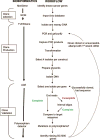Functional proteomics approach to investigate the biological activities of cDNAs implicated in breast cancer
- PMID: 16512675
- PMCID: PMC2522320
- DOI: 10.1021/pr050395r
Functional proteomics approach to investigate the biological activities of cDNAs implicated in breast cancer
Abstract
Functional proteomics approaches that comprehensively evaluate the biological activities of human cDNAs may provide novel insights into disease pathogenesis. To systematically investigate the functional activity of cDNAs that have been implicated in breast carcinogenesis, we generated a collection of cDNAs relevant to breast cancer, the Breast Cancer 1000 (BC1000), and conducted screens to identify proteins that induce phenotypic changes that resemble events which occur during tumor initiation and progression. Genes were selected for this set using bioinformatics and data mining tools that identify genes associated with breast cancer. Greater than 1000 cDNAs were assembled and sequence verified with high-throughput recombination-based cloning. To our knowledge, the BC1000 represents the first publicly available sequence-validated human disease gene collection. The functional activity of a subset of the BC1000 collection was evaluated in cell-based assays that monitor changes in cell proliferation, migration, and morphogenesis in MCF-10A mammary epithelial cells expressing a variant of ErbB2 that can be inducibly activated through dimerization. Using this approach, we identified many cDNAs, encoding diverse classes of cellular proteins, that displayed activity in one or more of the assays, thus providing insights into a large set of cellular proteins capable of inducing functional alterations associated with breast cancer development.
Figures





Similar articles
-
Gene expression signatures and biomarkers of noninvasive and invasive breast cancer cells: comprehensive profiles by representational difference analysis, microarrays and proteomics.Oncogene. 2006 Apr 13;25(16):2328-38. doi: 10.1038/sj.onc.1209265. Oncogene. 2006. PMID: 16314837
-
MLK3 is critical for breast cancer cell migration and promotes a malignant phenotype in mammary epithelial cells.Oncogene. 2010 Aug 5;29(31):4399-411. doi: 10.1038/onc.2010.198. Epub 2010 May 31. Oncogene. 2010. PMID: 20514022
-
Semaphorin-plexin signalling genes associated with human breast tumourigenesis.Gene. 2011 Dec 10;489(2):63-9. doi: 10.1016/j.gene.2011.08.024. Epub 2011 Sep 2. Gene. 2011. PMID: 21925246
-
Cloning and characterisation of cDNAs encoding a novel non-receptor tyrosine kinase, brk, expressed in human breast tumours.Oncogene. 1994 Aug;9(8):2383-90. Oncogene. 1994. PMID: 8036022
-
A conserved region within interferon regulatory factor 5 controls breast cancer cell migration through a cytoplasmic and transcription-independent mechanism.Mol Cancer. 2015 Feb 4;14(1):32. doi: 10.1186/s12943-015-0305-5. Mol Cancer. 2015. PMID: 25649192 Free PMC article.
Cited by
-
HTLV-1 basic leucine zipper factor protects cells from oxidative stress by upregulating expression of Heme Oxygenase I.PLoS Pathog. 2019 Jun 28;15(6):e1007922. doi: 10.1371/journal.ppat.1007922. eCollection 2019 Jun. PLoS Pathog. 2019. PMID: 31251786 Free PMC article.
-
Genetic and chemical targeting of epithelial-restricted with serine box reduces EGF receptor and potentiates the efficacy of afatinib.Mol Cancer Ther. 2013 Aug;12(8):1515-25. doi: 10.1158/1535-7163.MCT-12-1110. Epub 2013 May 30. Mol Cancer Ther. 2013. PMID: 23723125 Free PMC article.
-
Non-germline genetically engineered mouse models for translational cancer research.Nat Rev Cancer. 2010 Jul;10(7):470-80. doi: 10.1038/nrc2877. Nat Rev Cancer. 2010. PMID: 20574449 Free PMC article. Review.
-
Integration of an LPAR1 Antagonist into Liposomes Enhances Their Internalization and Tumor Accumulation in an Animal Model of Human Metastatic Breast Cancer.Mol Pharm. 2023 Nov 6;20(11):5500-5514. doi: 10.1021/acs.molpharmaceut.3c00348. Epub 2023 Oct 16. Mol Pharm. 2023. PMID: 37844135 Free PMC article.
-
Identification of novel pro-migratory, cancer-associated genes using quantitative, microscopy-based screening.PLoS One. 2008 Jan 23;3(1):e1457. doi: 10.1371/journal.pone.0001457. PLoS One. 2008. PMID: 18213366 Free PMC article.
References
-
- Nielsen KV, Niebuhr E, Ejlertsen B, Holstebroe S, Madsen MW, Briand P, Mouridsen HT, Bolund L. Molecular cytogenetic analysis of a nontumorigenic human breast epithelial cell line that eventually turns tumorigenic: validation of an analytical approach combining karyotyping, comparative genomic hybridization, chromosome painting, and single-locus fluorescence in situ hybridization. Genes Chromosomes Cancer. 1997;20:30–37. - PubMed
-
- Nishizaki T, DeVries S, Chew K, Goodson WH, 3rd, Ljung BM, Thor A, Waldman FM. Genetic alterations in primary breast cancers and their metastases: direct comparison using modified comparative genomic hybridization. Genes Chromosomes Cancer. 1997;19:267–272. - PubMed
-
- Perou CM, Jeffrey SS, van de Rijn M, Rees CA, Eisen MB, Ross DT, Pergamenschikov A, Williams CF, Zhu SX, Lee JC, Lashkari D, Shalon D, Brown PO, Botstein D. Distinctive gene expression patterns in human mammary epithelial cells and breast cancers. Proc Natl Acad Sci U S A. 1999;96:9212–9217. - PMC - PubMed
-
- Porter DA, Krop IE, Nasser S, Sgroi D, Kaelin CM, Marks JR, Riggins G, Polyak K. A SAGE (serial analysis of gene expression) view of breast tumor progression. Cancer Res. 2001;61:5697–5702. - PubMed
-
- Ma XJ, Salunga R, Tuggle JT, Gaudet J, Enright E, McQuary P, Payette T, Pistone M, Stecker K, Zhang BM, Zhou YX, Varnholt H, Smith B, Gadd M, Chatfield E, Kessler J, Baer TM, Erlander MG, Sgroi DC. Gene expression profiles of human breast cancer progression. Proc Natl Acad Sci U S A. 2003;100:5974–5979. - PMC - PubMed
Publication types
MeSH terms
Substances
Grants and funding
LinkOut - more resources
Full Text Sources
Other Literature Sources
Medical
Research Materials
Miscellaneous

